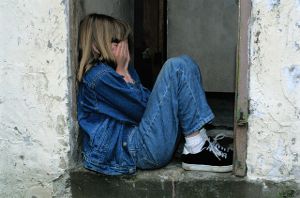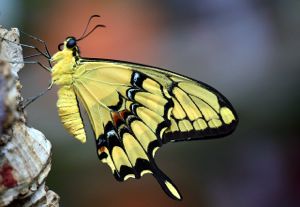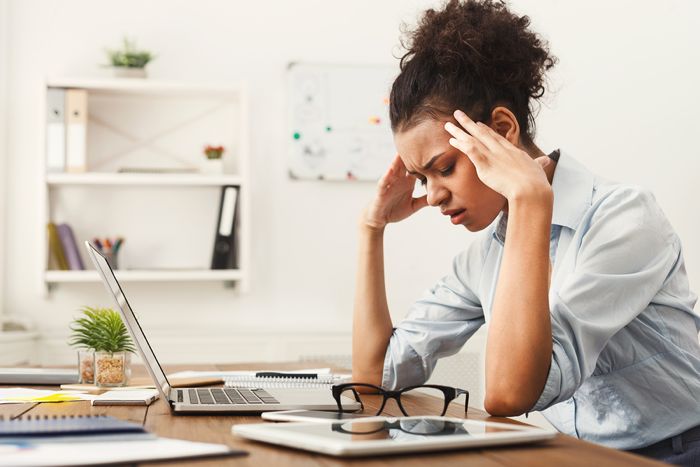Do you struggle with migraine headaches?
I used to get them a lot. Now, only occasionally. Fortunately through my regular health research and writing, I discovered what was causing mine and was able to find treatments that work for me. (My main one is butterbur—you can read more about that in a previous post, “Allergy Headaches? I Tried Butterbur—It Helps!”)
Here’s something I’ve been wondering about, though: Do writers and other creative artists suffer from headaches more often than the rest of the population? And if so, what can we do about it?
Famous Writers Who’ve Suffered with Migraine Headaches
We do know that a number of famous writers were victims to the painful grips of frequent migraines.
Historians believe Emily Dickinson, who wrote about feeling “a funeral in my brain,” suffered from intense headaches and neurological symptoms that are characteristic of migraines.
Joan Didion actually helped increase awareness of migraines through her writing, stating in her essay “In Bed” that all who have migraines “suffer not only from the attacks themselves but from this common conviction that we are…making ourselves sick, that we ‘bring it on ourselves….’”
Virginia Woolf also wrote about her migraines, while making it clear that trying to explain to someone who doesn’t suffer from them was near impossible. In her essay “On Being Ill,” she wrote, “let a sufferer try to describe a pain in his head to a doctor and language at once runs dry.”
Lewis Carrol, author of Alice’s Adventures in Wonderland, suffered too, to the point that historians believe some of the distortions Alice experiences in her story were inspired by the author’s symptoms.
Does that mean writers are particularly susceptible to migraines? Writer and entrepreneur Jamey Stegmaier thinks maybe it does: “Lately on Twitter I’ve noticed a lot of people talking about their migraine headaches. I’ve been getting a lot of headaches lately too. Today it dawned on me…these people are all writers. Every one of them.”
3 Reasons Why Writers May be More at Risk for Migraine Headaches
In my research, I haven’t yet found any conclusive studies showing that creative people are more likely to suffer migraines. BUT, there are several things that point to the probability that writers and other creative artists may be at an increased risk for them.
 1. Creativity Often Stems from Emotional Trauma in Childhood
1. Creativity Often Stems from Emotional Trauma in Childhood
Research has found a couple things that may set writers up for a higher risk of migraines.
Emotional trauma in childhood often spawns creativity, and many writers recall a less than ideal childhood.
Any sort of abuse, including emotional abuse, tends to cause a child to retreat from the situation into his or her mind, escaping inwardly as a way to cope. This sort of mental retreat is called “dissociation,” which can vary from mild detachment from one’s surroundings to a more severe removal from reality.
In a 2015 study, researchers found that dissociation was related to creativity. It seems that dissociative states can encourage the development of imagination, fantasy, and even “imaginary friends.” (Sounds a lot like characters in a story, doesn’t it?) All of these can soothe a child in an abusive situation, but can also set the stage for adulthood creativity.
“Many people are drawn to creative expression as part of their way to heal from trauma, and regain self esteem and emotional control,” says Douglas Eby (M.A./Psychology).
In turn, researchers have connected childhood trauma to migraines. In a 2016 study, researchers found that participants who recalled emotional abuse in childhood and adolescence were over 50 percent more likely to have migraines. If a person reported experiencing all three types of abuse (physical, emotional and sexual), the risk of migraines doubled.
If childhood trauma is related to creativity and to migraines, both, might creative people be more at risk? I found no studies answering that direct query, but it definitely possible.
 2. Writers Spend a Lot of Time in Front of Computer Screens
2. Writers Spend a Lot of Time in Front of Computer Screens
You know you are. You’re in front of your computer, tablet, cell phone, and other screens for many hours out of the day. You have to be to write, research, and market, while keeping all your social media platforms humming.
All that screen time, though, may increase your risk of migraines. A number of studies have found a connection. In a 2014 study, scientists found that the more time participants spent in front of their screens, the more headaches they experienced.
Earlier research involving over 30,000 people showed that screen use was a likely predictor of headaches (and back pain). In a 2016 study, researchers found again that high levels of screen time exposure were associated with migraine.
Some scientists think the link may be associated with computer vision syndrome (CVS)—the fact that computer screens tend to tire and dry out the eyes (which can trigger migraines in those vulnerable to them). Read more about CVS and how to protect your eyes while working on the computer in our previous post, “What Your Computer is Doing to Your Eyes.”
Other studies have found, though, that screen time increases frequency of headaches regardless of the effect on the eyes, and that computer use can lead to attacks in those who suffer from migraine headaches.
 3. Writers are Often Highly Sensitive, Which Increases Risk of Migraine Headaches
3. Writers are Often Highly Sensitive, Which Increases Risk of Migraine Headaches
Many writers are “highly sensitive” people, meaning that they are more acutely aware of lights, sounds, and textures around them.
(Not sure if you’re highly sensitive? Read our post, “How to Overcome Unique Challenges as a Highly Sensitive Writer.”)
Research on highly sensitive individuals shows that:
- they have rich and complex inner lives, and
- they are deeply moved by music and art.
Creativity coach Lisa A. Riley states, “Throughout my practice, I have encountered a connection between highly sensitive people and their own creative impulses….Creatives often feel and perceive more intensely, dramatically, and with a wildly vivid color palate to draw from, which can only be described as looking at the world through a much larger lens.”
The good news is that this heightened sensitivity helps us when we’re imagining characters interacting in a story, but it can hurt us when it comes to being vulnerable to migraine triggers.
Harsh lights (particularly fluorescents) and loud sounds have both been identified as common triggers for migraine headaches, and these can have an even larger negative effect on highly sensitive migraine sufferers than those who aren’t highly sensitive.
Migraines and Light
Indeed, one of the reasons computer use may trigger migraines is because of the brightness of the screen, or the blue light that emanates from most of them. In a 2007 study, researchers found that common migraine triggers included lights and heat.
In another small study, researchers used MRIs to examine areas of the brain associated with visual and auditory processing in those with migraines. They found an increased connectivity between primary visual and auditory processors in migraine sufferers, which could explain why lights and sounds can trigger headaches.
Here’s something even more interesting: In a 2017 study, researchers found that light exposure could lead to negative emotions in migraine sufferers. Whereas those without sensitivity to light cited pleasant emotions when exposed to the study lighting, those with migraines said the lighting made them feel fear, anger, anxiety, and depression.
The study also found that the lighting provoked physical symptoms like chest tightness and shortness of breath.
 What to Do if You’re a Writer with Migraine Headaches
What to Do if You’re a Writer with Migraine Headaches
Of course, migraines can be triggered by a number of other things, including the following:
- Allergies (this is a big one and was one of the main factors in my headaches)
- Hormones (another very common one—women often experience migraines around the time of their menstrual cycles)
- Sleep (sleep deprivation is a powerful migraine trigger)
- Stress
- Diet (aged cheeses, alcohol, soy, MSG, nitrites)
- Perfumes and strong odors
- More
What can you do if you’re one of those unlucky writers who suffers from migraines? I have one huge piece of advice for you: Don’t give up. It took me years to find out what was causing mine, but I’m so glad I hung in there as I don’t have nearly as many as I used to, and life is much better that way!
In my experience, it’s not just one thing that causes migraines, but a myriad of things working together. For instance, my main triggers for migraines are allergies and hormones, but I’ve also found that these factors are more likely to cause headaches if another factor is also in play.
Maybe I didn’t get enough sleep the night before, or I was traveling and didn’t get regular meals (hunger can trigger migraines). Maybe I was under a lot of stress, or exposed to more bright lights and noises than usual (such as in an airport or an office).
Your migraines, too, are likely affected by a number of things.
Keep a Migraine Headaches Diary
Keep a diary for at least two weeks to give yourself the data you need to find out what may be triggering yours.

Then fill in the details every day for two weeks. Note if you slept well, what you had to eat and drink for every meal, etc.
Once you identify possible triggers, you can go to work trying to eliminate them. Here are a few suggestions:
- Get at least 7-8 hours of sleep per night.
- If you find that certain foods seem to precede your migraines, try cutting them out of your diet for a month or so and see if it helps.
- Eat regular meals and small snacks every 3-4 hours.
- If allergies are a potential problem, try butterbur and feverfew. Both have been found in studies to help reduce allergy symptoms, including headaches.
- Ask your gynecologist about any hormonal triggers you may be having.
- Practice good lighting in your writing nook and where you work. Lamps positioned beside you are always more comfortable than bright lights blaring over your head. In general, the brighter the light, the more likely the headache.
- Get an anti-glare screen for your computer monitor, or ask your doctor about anti-glare lenses for your glasses.
- Invest in some noise-canceling headphones, or use regular old earplugs to protect yourself if you’re sound sensitive.
- Practice regular stress relief. Exercise is excellent. You are also likely to benefit from yoga and/or tai chi.
One more little trick. If you’re light sensitive, try green light bulbs. In one 2016 study, researchers found that green was the least likely to exacerbate migraine headaches, when compared to white, blue, amber, or red light.
How do you manage with migraines as a writer?
Sources
Bullock, G. (2017, July 5). How Does a Person with Migraine React to Light Exposure? Retrieved from https://www.theraspecs.com/blog/how-does-a-person-with-migraine-react-to-light-exposure/
Bullock, G. (2018, March 22). Computer Screens: The Effect on Headaches, Migraines and Concussions. Retrieved from https://www.theraspecs.com/blog/computer-screens-headaches-migraines-and-concussions/
Eby, D. (2017, April 21). Traumatic Childhood, Creative Adult | TalentDevelop. Retrieved from http://talentdevelop.com/6175/traumatic-childhood-creative-adult/
Glaser, A. (2017, June 29). Famous Artists with Migraine Throughout History. Retrieved from https://migraineagain.com/famous-artists-with-migraine-throughout-history/
GPS, S. (2017, June 25). Trauma, Dissociation & Creativity and How They Relate to Narcissistic Abuse. Retrieved from https://medium.com/@SoulGPS/trauma-dissociation-creativity-and-how-they-relate-to-narcissistic-abuse-685533b608f0
Karmakar, M. (2016, July 11). Why emotional abuse in childhood may lead to migraines in adulthood. Retrieved from http://theconversation.com/why-emotional-abuse-in-childhood-may-lead-to-migraines-in-adulthood-59226
Kelman, L. (2007). The Triggers or Precipitants of the Acute Migraine Attack. Cephalalgia, 27(5), 394-402. doi:10.1111/j.1468-2982.2007.01303.x
Montagni, I., Guichard, E., Carpenet, C., Tzourio, C., & Kurth, T. (2016). Screen time exposure and reporting of headaches in young adults: A cross-sectional study. Cephalalgia, 36(11), 1020-1027. doi:10.1177/0333102415620286
Noseda, R., Bernstein, C. A., Nir, R., Lee, A. J., Fulton, A. B., Bertisch, S. M., … Burstein, R. (2016). Migraine photophobia originating in cone-driven retinal pathways. Brain, 139(7), 1971-1986. doi:10.1093/brain/aww119
Noseda, R., Lee, A. J., Nir, R., Bernstein, C. A., Kainz, V. M., Bertisch, S. M., … Burstein, R. (2017). Neural mechanism for hypothalamic-mediated autonomic responses to light during migraine. Proceedings of the National Academy of Sciences, 114(28), E5683-E5692. doi:10.1073/pnas.1708361114
Riley, L. A. (2018, March 16). Highly Sensitive Personality and Creativity | Highly Sensitive and Creative. Retrieved from http://highlysensitive.org/325/highly-sensitive-personality-and-creativity/
Stegmaier, J. (2010, February 25). Are Writers More Likely to Get Migraines? Retrieved from http://jameystegmaier.com/2010/02/are-writers-more-likely-to-get-migraines/
Taehtinen, R. E., Sigfusdottir, I. D., Helgason, A. R., & Kristjansson, A. L. (2014). Electronic screen use and selected somatic symptoms in 10–12year old children. Preventive Medicine, 67, 128-133. doi:10.1016/j.ypmed.2014.07.017
Tietjen, G. E., Karmakar, M., & Amialchuk, A. A. (2016). Emotional Abuse History and Migraine Among Young Adults: A Retrospective Cross-Sectional Analysis of the Add Health Dataset. Headache: The Journal of Head and Face Pain, 57(1), 45-59. doi:10.1111/head.12994
Torsheim, T., Eriksson, L., Schnohr, C. W., Hansen, F., Bjarnason, T., & Välimaa, R. (2010). Screen-based activities and physical complaints among adolescents from the Nordic countries. BMC Public Health, 10(1), 324. doi:10.1186/1471-2458-10-324
Tso, A. R., Trujillo, A., Guo, C. C., Goadsby, P. J., & Seeley, W. W. (2015). The anterior insula shows heightened interictal intrinsic connectivity in migraine without aura. Neurology, 84(10), 1043-1050. doi:10.1212/wnl.0000000000001330
Van Heugten – van der Kloet, D., Cosgrave, J., Merckelbach, H., Haines, R., Golodetz, S., & Lynn, S. J. (2015). Imagining the impossible before breakfast: the relation between creativity, dissociation, and sleep. Frontiers in Psychology, 06. doi:10.3389/fpsyg.2015.00324


I found out that getting enough sleep solves the migraine problem successfully!
Glad that worked for you, Nick! Yes, as mentioned above, lack of sleep can be a powerful migraine trigger. :O)